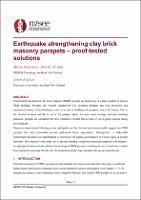| dc.contributor.author | Giaretton, Marta | |
| dc.contributor.author | Dizhur, Dmytro | |
| dc.contributor.author | Ingham, Jason | |
| dc.date.accessioned | 2023-08-28T04:23:35Z | |
| dc.date.available | 2023-08-28T04:23:35Z | |
| dc.date.issued | 2023-04-19 | |
| dc.identifier.uri | https://repo.nzsee.org.nz/xmlui/handle/nzsee/2614 | |
| dc.description.abstract | Unrestrained unreinforced clay brick masonry (URM) parapets are found atop of a large number of vintage URM buildings. Parapets are typically cantilevered wall structural elements that form decorative and ornamental features of the building facades or in case of building side parapets, form a fire barrier. Due to the elevated location and the extent of the parapets above the main street frontage and main building entrances, parapets are considered the most vulnerable element that is prone to out-of-plane collapse during an earthquake.
Numerous observations following recent earthquakes in New Zealand and internationally suggest that URM parapets that were previously secured performed below expectations. Subsequently, a shake-table experimental program was implemented to investigate the seismic performance of various types of parapet restraints. The objective of the study was to provide building owners and practicing engineers with industry-accepted proof-tested retrofit solutions for securing of URM parapets, including the use of steel brace, timber brace and post-tensioning. Results and observations from the experimental study are presented herein. | |
| dc.language.iso | en | |
| dc.publisher | New Zealand Society for Earthquake Engineering | |
| dc.relation.ispartofseries | 2023;131 | |
| dc.subject | Risk mitigation by retrofitting | |
| dc.title | Earthquake strengthening clay brick masonry parapets – proof-tested solutions | |
| dc.type | Article | |

